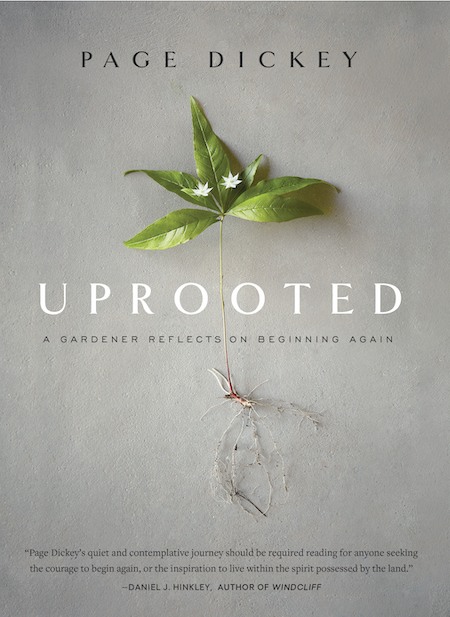Book Review: Uprooted
I am a big fan of garden memoirs (as evidenced here, here and here) because they dig deep into why each of us gardens. Paige Dickey’s new book, Uprooted: A Gardener Reflects on Beginning Again (Timber Press, 2020), is a beautiful example of the genre—beautifully imagined, beautifully written, beautifully photographed. It’s one of the best books about gardening that I’ve read in years.
 Dickey is a long-time garden writer and for more than two decades owned a garden in Westchester County, New York, called Duck Hill. That garden was often photographed for articles and books, and included rows of clipped hedges and immense perennial borders. It was an intensely cultivated garden, and an expensive and exhausting one to keep up. In her mid-70s with a husband pushing 80, Dickey moved—and not to a senior condo. The couple uprooted themselves and went from three intense acres to 17 wilder acres in rural Connecticut.
Dickey is a long-time garden writer and for more than two decades owned a garden in Westchester County, New York, called Duck Hill. That garden was often photographed for articles and books, and included rows of clipped hedges and immense perennial borders. It was an intensely cultivated garden, and an expensive and exhausting one to keep up. In her mid-70s with a husband pushing 80, Dickey moved—and not to a senior condo. The couple uprooted themselves and went from three intense acres to 17 wilder acres in rural Connecticut.
The book details the sadness of leaving a garden you have nurtured for a long time and the excitement of building a new home and garden in a new place. She walks readers through the sale of her old garden, purchasing the new one, designing the house, and then joyfully she explores each of the gardens and wild areas on the property. I will admit that one reason I loved Uprooted so much is that Dickey and I are soul sisters in terms of plants. She loves serviceberries (in the East they call them shadblows because it is a different species of Amelanchier that we grow here.) Her perennial borders are filled with favorite plants that grow well in the North, too: Amsonia, Baptisia, Siberian iris, Russian sage, Boltonia, peonies, asters. Even Henry Eilers rudbeckia—my favorite rudbeckia cultivar—is in her garden.
Embracing the Land
As she’s gotten older and in an area with rare ecosystems on the property, she’s grown to embrace native plants. She tamps down her desires to create more formal gardens and instead rips invasive plants out of the property and watches as the natives move in and flourish. You’ll learn a lot about how to nurture natives in wild and semi-wild settings by reading her narrative. Dickey is honest, too, about gardening as you get older. She grows a lot of hydrangeas in the gardens near the house because they are easy. She has hired help—a handyman who comes once a week to deal with the heavy lifting and a young woman who helps tend her cutting garden.
Finally, the book is just beautifully written. Her prose is clean, precise, poetic, and occasionally funny, such as when Dickey buys small slips of fruit trees for the orchard she and her husband are putting in and he comments, “You know how old I am.” The photographs, mostly by Ngoc Minh Ngo, add to the delight.
If you are looking for a book to give to an experienced gardener or to one who savors plants and the environment, you can’t go wrong with Uprooted.


One Comment
-
Pingback: 6 Ways to Downsize Your Garden Gently - Minnesota State Horticultural Society
Back to Blog